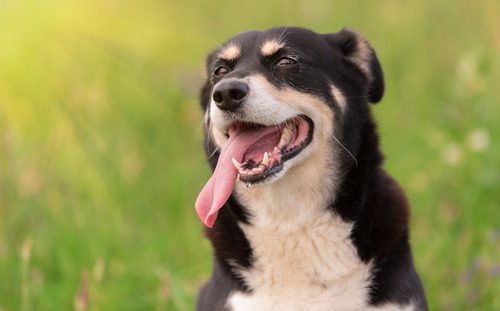Why Do Dogs Pant?

Panting is a common behavior in dogs, but have you ever wondered why your dog does it and what it could mean? While dog panting is often linked to heat, excitement, or exercise, it can also point to underlying health concerns that shouldn’t be overlooked. Recognizing the differences between normal and abnormal panting can help you better understand your pet’s behavior and know when a veterinary visit may be necessary. This blog explores the reasons behind dog panting, when it’s considered normal, and when it may be a sign of something more serious. Whether your dog pants heavily after a walk or suddenly starts breathing faster at rest, this guide can help clarify what’s going on. Keep reading to learn more about this natural (and sometimes concerning) behavior and how Yalesville Veterinary Hospital can help if you ever have questions or concerns.
The Primary Reasons Dogs Pant
Panting is a normal and important way for dogs to regulate their body temperature. Unlike humans, dogs don’t sweat through their skin. Instead, they rely on their respiratory system to cool down. This type of panting typically happens after physical activity or during warmer weather and is often accompanied by other signs of exertion, such as drooling or lying down to rest.
Temperature Regulation
When dogs get hot, they rely on evaporative cooling through their tongues, nasal passages, and lungs. As they pant, moisture evaporates, carrying away heat and helping lower their core temperature. This is especially important during summer months or after vigorous play sessions.
After Exercise or Play
It’s completely normal for dogs to pant after running, playing fetch, or going on a brisk walk. This type of panting should gradually slow down as they cool off and rest. The heavier the exertion, the longer it may take for their breathing to return to normal.
Emotional Excitement or Stress
Panting isn’t always about temperature. Dogs may also pant when they’re excited, anxious, or nervous. For example, panting often increases during car rides, vet visits, thunderstorms, or when meeting new people. These situations trigger a stress response that can affect their breathing.
When Dog Panting Might Be a Concern
While dog panting is often harmless, there are times when it can indicate a medical issue. Pet owners should pay attention to the frequency, intensity, and context of their dog’s panting especially if it seems out of character or occurs at rest.
Heatstroke and Overheating
Excessive panting, especially in hot weather, could be an early sign of heatstroke. This condition is dangerous and develops when a dog can’t cool down effectively. In addition to panting, signs may include drooling, weakness, red gums, vomiting, or collapse. Certain breeds with shorter snouts (like Bulldogs and Pugs) are more prone to overheating.
Respiratory or Cardiovascular Conditions
Panting can sometimes reflect breathing issues or heart problems. If your dog pants heavily without physical exertion or starts doing so more often than usual, it could point to issues like bronchitis, laryngeal paralysis, or congestive heart failure. These conditions affect oxygen flow and can increase respiratory rate.
Pain or Discomfort
Dogs don’t always show pain in obvious ways. Instead, they may pant more frequently, especially if they’re dealing with internal discomfort, joint pain, or injury. If panting appears suddenly alongside restlessness, loss of appetite, or a change in posture, it could be a pain response.
Side Effects from Medications
Some medications, such as steroids or certain heart drugs, can cause increased panting as a side effect. If your dog has recently started a new medication and you notice changes in their breathing, reach out to your vet for guidance.
Age, Breed, and Health Factors That Influence Panting
Dog panting can vary depending on your dog’s age, breed, and overall health. Some pets are simply more prone to breathing heavily, while others may develop new issues as they grow older.
Brachycephalic Breeds
Flat-faced breeds like Boston Terriers, Boxers, Bulldogs, and Shih Tzus often pant more due to their shortened airways. Even mild activity or heat can challenge their ability to breathe comfortably. This group requires extra attention when it comes to managing panting and heat exposure.
Senior Dogs
Older dogs may pant more due to chronic pain (like arthritis), decreased lung or heart function, or endocrine issues. Conditions such as Cushing’s disease, which affects hormone regulation, are also known to cause persistent panting.
Overweight Dogs
Excess weight puts added strain on a dog’s heart and lungs. Obese dogs may pant even after mild exercise or during rest, as their bodies work harder to move and regulate temperature. Managing your dog’s weight can improve their breathing and overall health.
Signs That Dog Panting May Require Veterinary Attention
Knowing when to seek help is key to your dog’s health. If panting appears abnormal, worsens over time, or happens without an obvious cause, it’s best to call your veterinarian.
Red Flags to Watch For
- Panting that begins suddenly or seems labored
- Gums or tongue that appear pale, bluish, or overly red
- Drooling with no interest in water or food
- Weakness or collapse
- Unresponsive behavior or signs of distress
If you notice any of these signs, call Yalesville Veterinary Hospital at (203) 265-1646 or bring your pet in for an evaluation. Quick action could prevent a more serious outcome.
How Your Vet Can Help Diagnose the Cause of Dog Panting
Your veterinarian can evaluate your dog’s panting through a combination of physical exams, lab work, and possibly diagnostic imaging. These tools help identify whether panting is heat-related or connected to a medical condition.
What to Expect at the Appointment
During a veterinary visit, your vet may:
- Ask about your dog’s behavior, history, and environment
- Listen to their heart and lungs for abnormalities
- Check for pain, fever, or signs of injury
- Run blood tests or X-rays to check internal health
This evaluation provides insight into whether your dog’s panting is a normal behavior or if something more serious is at play.
Help Your Dog Breathe Easy with Trusted Veterinary Support
Dog panting is one of those behaviors that’s easy to overlook until it changes or becomes excessive. While most panting is perfectly normal, there are times when it can indicate a problem worth addressing. Whether your dog just finished a long walk or seems to pant for no clear reason, staying informed is the best first step. If your pet’s panting feels unusual or frequent, our team at Yalesville Veterinary Hospital in Yalesville, Connecticut is here to help. Give us a call at (203) 265-1646 or book an appointment online today to make sure your dog gets the care they need to stay comfortable and healthy.
